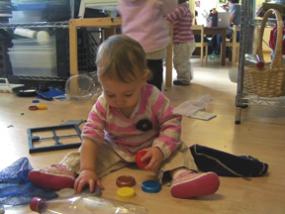Play with Lids - From Individual to Social

Why put two lids together? What drives this action? This one-year-old child is probably not sorting the lids by color or size, but rather has some purpose that causes her to persist at some moves and avoid others. Watch to see if she is trying to insert one lid into the other, trying to sandwich two lids into a pair that she can hold as a unit, trying to make the lids align in a stack or simply trying to create a condensed pile. Notice when she changes her mind and moves a lid from one place to another. What does the new placement offer that the previous placement lacks? Can you figure out why she does not like the lid where it is? What is wrong with that relation? Does she invert the lids to place the open side down, as if to cover a smaller object with the lid? Notice how she persists at a placement that is “almost what she wants.” What is it that you think she wants? She seems to return to the red lid often. What do you think she is looking for when she holds the red lid? At one point (around 20 seconds into the clip) she holds the red lid, looks around at the other lids, and sighs. What could that signify? In a few places she makes a relation between two blocks that seem to have a new status, as if she has made something special. She holds this accomplishment up toward the teacher. If she could verbalize, what do you think she would say?
Around 1.5 minutes into the clip the action becomes more social. A slightly older child stoops in front of the younger girl. The younger girl holds out two white lids to the older child. The older child takes them. Do you think the younger child was showing the older child the two lids or offering them to the older child to take? Here we see a good example of an action that can be interpreted in two different ways. As children mature socially, they become increasingly skilled at reading the intentions of other children, e.g., showing or offering. These skills at reading social cues greatly improve interactive play among children. Do you see any misreads in this video clip in the seconds that follow? How does the younger child signal the intentions of her actions or attitude toward the actions of the older child? What is the older child trying to accomplish by holding the younger child’s face and lifting it up? How does the younger child communicate her reaction to her face being pressed and lifted? Does the older child adjust her actions as a result of reading the younger child’s signals?
Continue to answer these sorts of questions as you watch a third child enter the scene. What strategies does the third child use to establish a relation with the younger, preverbal, child? Compare the strategies the two older children use and decide how they are different in term of their effectiveness, perspective taking, and developmental appropriateness. This segment of the video clip presents many examples of strategies of engagement. Some of the strategies of engagement are directed at the young child herself. Some strategies involve co-playing with the lids. Which strategies do you think lead to a better quality of play? Again, these are the details of social development. Enjoy the rest of the clip. Don’t miss the little jewel during the last 15 seconds. The younger child sort of wipes her hands clean after her friend swipes the white lid away on the floor. Can we resist thinking that this gesture means “all gone, and I am okay with that?” Gestures are often self-expressions to consolidate a feeling and are not necessarily a communication to others. Don’t miss these delightful details when you observe children or revisit a video of children at play.
